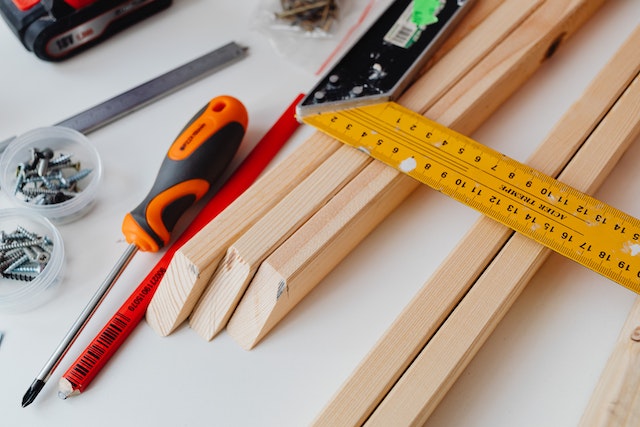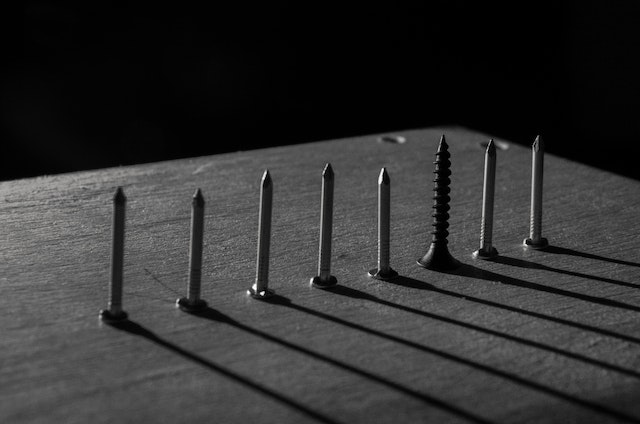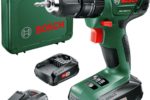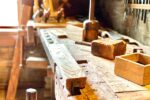How To Make A Woodworking Bench: A Beginner’s Guide

A woodworking bench is an essential tool for any woodworker, whether you’re a beginner or an experienced craftsman. A good bench not only provides a sturdy and stable surface to work on, but it can also help you to work more efficiently and safely.
In this article – How To Make A Woodworking Bench: A Beginner’s Guide, we’ll show you how to make a woodworking bench from scratch, even if you’re a beginner. We’ll cover everything you need to know, from selecting the right materials, to designing and building a bench that suits your specific needs.
With our easy-to-follow instructions and helpful tips, you’ll be able to make a bench that will serve you well for years to come. So, let’s dive into the world of woodworking and discover how to make a woodworking bench that will be a valuable addition to your workshop!
Tools You’ll Need
‘Alright, if you are a beginner in woodworking and want to make your own bench, the first step is to round up the tools you need to get the job done. Nothing’s more frustrating than realizing you don’t have the proper tools when you’re half a project in!
To get started, you need a power drill. A power drill is your best friend for any project involving wood. You’ll need it to drill the holes for screws to secure the pieces together. Once you have the power drill, grab an electric saw so you can start cutting those pieces of wood into the right shape and size.
You’ll also need a hammer and a level, both of which are great for ensuring that your bench is coming together correctly and looks even too. Lastly, don’t forget the screws; they’re also essential for making sure all the pieces are secure.
So to recap: power drill, electric saw, hammer, level, and screws. You’ll thank yourself later when you have all these basic tools at the ready and won’t waste any time running around to get things together.
Now let’s move on to the materials you’ll need for this project…’
Power Drill
Oh, you’re trying to build yourself a woodworking bench? You’ll need a power drill! Now I know what you’re thinking..a power drill? Aren’t you getting a bit ahead of yourself? Well, I’m here to tell you that a power drill is an essential tool for when you’re creating a woodworking bench. Without it, your project will simply be a pile of wood and nails.
Now listen carefully – because this is where the magic begins. A power drill allows you to more easily and quickly drill holes through a variety of materials. It has a chuck, which is the end of the drill that holds the bit firmly, and the bit is what actually drills through the wood. And don’t forget, it runs on electricity! It’s the perfect tool for when you’re assembling your woodworking bench.
You’ll need to figure out the size of your drill bit. I recommend a 5/16 bit or larger. You also need to pick up a few extra long drill bits, just in case you need to make special cuts. And don’t forget the drill is reversible, which means it can go two directions – clockwise and counterclockwise.
Now let’s talk safety. I don’t want you getting hurt, so please make sure to keep the cord and drill away from water, and never touch the bit or the side of the drill when it’s on. Also, when you’re drilling, press down evenly and don’t force the drill through the wood. If the drill bit seems to be getting stuck, stop and make sure everything is lined up properly.
And that’s your primer for power drills! Now, let’s move on to the materials needed for your woodworking bench.
Electric Saw

Alright folks, let’s get to the heart of the matter and talk about the second tool I mentioned you’ll need for this project: the Electric Saw! After all, you can’t ride your bench to the store to pick up one of those, and you don’t have time to waste waiting for it to arrive. With that in mind, I’m here to help guide you through the process of finding the right saw for your needs.
A good Electric Saw should be powerful enough to make quick, accurate cuts on a variety of materials. It also should be lightweight, so you don’t wear yourself out trying to carry it around all day. Oh, and you’ll need to make sure it’s cordless, so you don’t have to worry about where you’re going to plug it in!
Now, let’s move on to the features and accessories you’ll want to consider when buying your Electric Saw. You probably want to look for options that come with a blade guard, as this will help to protect you from any accidents that may occur while using the saw. You may also want to look for saws that come with adjustable blades, as this will allow you to customize your cuts according to the task at hand.
Finally, if you’re a beginner, you may want to look for saws that come with a guide rail. This will allow you to make precise and accurate cuts as you work.
So, if you’re looking to invest in an Electric Saw for your woodworking bench project, make sure you consider all of these features before you make your final decision. Remember: having the right tool for the job is half the battle! Good luck, and happy sawing!
Hammer
We all know and love the almighty Hammer – the tool that is always there to help us out when it comes to woodworking. But, without a hammer, all your hard work would just be a pile of splinters. So, it’s important to make sure you have one when you’re making your woodworking bench.
Hammering is an art form and it’s important to use the right hammer for the job. If you’re not sure which hammer to use, head on down to your local hardware store and get someone to help you out. You’ll want one with a good weight, so it’s easy to use, but still delivers enough power to help you bang out your projects, otherwise you’ll be there all night.
When it comes to Hammering, safety is the number one priority. Make sure you’re wearing something to protect your eyes and be sure to keep your face and hands away from where you’re hammering. And it’s always a good idea to have something to grab onto if you hit your thumb. Nothing ruins your day like having a swollen thumb!
When using your hammer, start gently and take your time, you want to make sure that you drive the nails all the way in, so your wood will stay together, otherwise it’ll just come apart once you put some weight on it. Also, make sure to use the correct size of nails for your particular project. Too small, and the wood won’t hold, too big and the holes will be too big and it’ll weaken the wood.
So, now that you know what to look for, and the dangers of hammering, you’re ready to begin making your woodworking bench. Just make sure you keep your hammer safe and don’t forget to wear safety glasses when you use it. That way, you’ll stay safe and have a great time making your bench!
Level
Now you can’t just go around aligning pieces of wood all willy-nilly, can you?! That would be terribly unbecoming of any seasoned woodworking expert. That’s why you must bring up your inventory of tools to include a level!
It may seem like a funny little thing it is essential to level surfaces of wooden pieces when you are assembling them together. Failure to do so may result in one of two things: A. Assembled furniture that can’t stand up straight or B. A piece of assembled furniture that looks like a bendy straw.
Now, quite frankly, neither one of those options are likely to bring out the “Oohs” and “Ahhs” that your family and friends are likely to produce when they see your newly assembled creation. So make sure you get your hands on a level before you start drilling and sawing.
A level is a tool used to make sure flat surfaces are, well, level. It is usually made of a straight ruler with a bubble in the center of it. The bubble is filled mainly with liquid and air to form a bubble that fits snuggly in the center of the ruler. Basically, when the bubble is at the center of the ruler, it indicates that the surface is level.
Now, there are various types of levels ranging from the basic wooden ruler to high tech laser level systems that can be used to make sure even the tiniest of surface imperfections are flattened. But for the craft of our beginner’s guide, the most basic level should suffice.
So, in summary, when adding a level to your tool chest, you must:
- Make sure the bubble is level at the center of the ruler
- Ensure its solid construction and accuracy by using different surfaces to test its readings
- Clean and store it in a safe place to prevent any wear and tear
Now you have all the tools and materials you need to create your woodworking bench. And don’t worry if you don’t have the right tools right away. You can always rent them from a local tool shop for a fraction of the price.
Screws

When it comes to woodworking, screws are our best friend! They are the unsung heroes of any woodworking bench project. With their help, we can easily join wood pieces together by secure binding, allowing for a stronger and more stable construction.
So let’s talk about screws: what do you need to know? Well, of course, first you need to buy the right type of screws. This will depend on the type of material you are using and the size of the holes that have to be drilled to accommodate your screws. If you’re using hardwood, opt for longer screws with a flat head, which will provide you with better holding power. If you’re using softwood, on the other hand, then get yourself some screws with a sharp point, which will make your life easier as you don’t have to predrill the holes.
In terms of sizes, the screw length should be twice the thickness of the materials being joined. For example, if you are joining two planks of wood measuring 1 inch each, then you should use screws that measure about 2 inches. The shankhole should also be big enough for the screw to pass through. This can range from ½ inch to about ¾ inch.
What else should you keep in mind when it comes to screws? Make sure you buy the ones that are galvanized, which means that they are covered with a layer of zinc to prevent them from rusting in case they get exposed to moisture.
Now let’s talk about drilling: do you have the right tools to do it? Of course, before you can use screws, you have to make holes in the wood, and you are going to need the right drill to do that. The size of the drill bit should be the same or a bit bigger than the diameter of the screw; otherwise, it might strip the threads and make it difficult for you to screw the pieces of wood together. Oh, by the way, to avoid splitting and cracking of the wood, don’t forget to drill pilot holes!
Finally, don’t forget about the type of screwdriver you need to drive the screws in. For most woodworking bench projects, the standard screwdriver will do, but if the screws are too tough, you might need to get yourself a powered screwdriver.
That’s all there is to know about screws! Now go and grab yourself some screws, choose the right type that fits your project, and getstarted building your woodworking bench. Happy building, woodworkers!
Materials Needed
Good morning, friends! Today we’re gonna be talking about the second step to make a woodworking bench, namely what materials you’ll need for this project. Now, as we all know, nothing comes for free in this life and almost every DIY project starts with a trip to the store.
So, let’s see. First you’ll need wood to build your bench. Now I want to be clear on this one. The type of wood you need is important and it depends on the purpose of your bench. Some hardwoods make ideal surfaces for cutting and carving while other woods like pine or poplar are better for furniture making. Whatever type of wood you need, make sure that it’s strong enough to support the weight of whatever you’ll be using it for.
Next up you’ll need some plastic caps. You might be wondering why you need plastic caps. Well, have you ever seen a finished piece of furniture with visible nail heads? No, I didn’t think so. Plastic caps are used to cover those nail heads and give your furniture a neat and finished look.
Finally, some nails will be required to build your bench. This is where it’s important to pick the right type of nail for the job. Make sure that the weight and length of the nails are suited to the particular type of wood you’re working with.
So that’s about it for the materials you need for building your woodworking bench. Now, as I always say, make sure to double-check your measurements and gather all the necessary supplies before you set to work. Trust me, Murphy’s Law is a real thing, so don’t take any risks!
That’s all I’ve got for you today my friends. Until next time, bye-bye!
Wood
When it comes to building your very own woodworking bench, you have to make sure you have the right material for the job. The material in question? Wood — that good old-fashioned, reliable and sturdy material. (And the title ‘How to Make a Woodworking Bench: A Beginner’s Guide’ didn’t give us a hint, did it now..?)
Now, the most important thing to remember when it comes to selecting wood for this project is that you don’t want to skimp. First and foremost, you need to make sure you get quality wood. Don’t just visit your local Home Depot or Wal-Mart and pick up the cheapest stuff on the shelf!
No siree! You want to make sure it feels strong and solid to the touch, that it doesn’t have any cracks or splinters, and that it’s free from any pests. Any questionable wood should be left for firewood – not for your woodworking project.
A good type of wood to make your bench from is oak, as it lasts a long time and is a very strong material. You can also use mahogany, pine or cherry — as long as it’s solid wood and in good condition.
And how much wood should you buy? Well, buy enough so that you can cut the pieces to size yourself. That way you can be sure that all your pieces are the exact same size and you don’t have to worry about mismatched measurements.
Another good tip I recommend is to mark the wood with chalk so you can remember the cuts you need to make. With a good strategy, you’ll save yourself a lot of time and trouble when it comes time to assemble the pieces of your precious DIY bench project.
So that’s it! You now have everything you need to get your hands on some quality wood for your DIY project. With that, you can get cracking and move onto the next step. So grab yourself a saw, grab yourself some wood, and get ready to make some sawdust!
Plastic Caps
Ho boy, are plastic caps important when it comes to making a woodworking bench! Without them, your bench just won’t be quite what you want it to be. They are like the crown on top of your hard work!
You’ll need to know how to use them correctly though, so don’t be too hasty in your woodworking bench-making endeavors. First, you need to buy plastic caps for your bench. Make sure to measure your bench so that you get the right size of caps. I recommend getting ones in your favorite color too, though that’s totally up to you.
Now, once you have purchased the caps, you need to use a hammer to attach them. Always use a wooden hammer – metal ones can cause your plastic to crack due to the extreme pressure. Starting from one end of your bench, place the caps and hammer them until you get to the other side. Be sure to leave a decent amount of space in between each cap for that professional finish!
When you are done, your bench will look even more professional with the perfect plastic caps applied. You can now rest assured that your woodworking bench will not just look great, but also be incredibly sturdy and reliable.
In summary, using plastic caps is essential when making a woodworking bench. All you need to do is measure your bench and get the right size. Don’t forget to use a wooden hammer to attach them to the bench – metal ones may be too harsh! Finally, when you are finished, your bench will look perfect, and last for years to come.
Nails

When you come to the part of your woodworking bench building where you have to use nails, you’d better be wary. Nails are an essential part of the assembly, but if you ain’t careful you can really make a mess of things. You’re gonna need something small and sharp, just a tiny nail to make all the big things sure and secure.
Before you start banging away, you don’t want to do something hasty, take the time and make sure you’ve got everything looking regal and stately, because if you ain’t careful you’re gonna end up with something real crappy. And you don’t want your bench to look like you found it in the junky.
Ain’t no shame in having to hit the home-improvement store, buying a wide variety of nails, small and large. You need to be prepared for all your nailing jobs, so get it all at once, and don’t skimp on buying too small!
You’ll have to exercise caution when you start nailing those pieces together, don’t use too many and make the wood look like it had some kind of feathers! If your nails aren’t going in with ease, that means your parts are done being put together with the squeeze.
Your nails also need to be of the correct size, too big and you’ve got a problem, too small and you can’t drive it, and then you’ll want to cry. Make sure it’s the right size and hammer it in with care, and you can join pieces together with a fit that won’t tear.
If your wood pieces aren’t coming together like they should, you might need some more nails and a bit more pressure could do some good. Don’t just grab any old nail either, measure the surface, get it right and you’ll nail it no matter how much wood you need to cover.
Make sure when you’re nailing you keep all the nails even, too many and your bench will look like a wild child blue. You don’t have to be an engineer to drive nails with finesse, just remember to take your time and you’ll make your bench look like a beauty in no time at all.
Assembly
Alrighty, now that you got your tools and materials ready, let’s get down to brass tacks and assemble the bench! Firstly, you need to mark out the shape of the bench with a pencil on the wood. This will help you get the best result for the size you’re aiming for. Now grab your electric saw and start cutting the wood according to the markings.
Next, you’ll need to do some drilling. Take your power drill and drill holes for the screws. Yup, this is gonna get a bit noisy, but don’t worry. Once you’re done with the drilling, it’s time to assemble the pieces together. If you have any doubts about it, feel free to use the hammer for accuracy and precision!
Now, to secure the borders you need to nail the end pieces together. That should do the trick! And don’t forget the plastic caps! Just stick ’em on and you’ll get a nice finish. Voila! You’ve officially completed the assembly of your woodworking bench. Ain’t that awesome? Take a step back and admire your hard work!
Mark Out the Shape of the Bench
Okay, now that you’ve gathered the tools and materials you are ready to move on to the first step of assembling your very own woodworking bench! Namely, you gotta figure out exactly how you want the bench to look. Sure, you know that ideally it should look like a flat surface with four legs attached – but whereabouts in the shop will your new work of art be situated?
Forget medieval tools, like chisels and whatnot, you are in the 21st century here. Put that level and ruler to use and mark the shape of the bench with our good old pencil. Heck, you don’t even need to make a circle; a simple square will do the trick here. Here’s my perspective: you are creating the basis for something that’s going to last for many years to come, so don’t go for the cheap solution here – it won’t do you any good if the shape of the bench is uneven.
When it comes to size, that’s another devil in the detail. Do you have enough floor space for a longer chair? Any wall shelves around that need to be accounted for? Or perhaps you want your woodworking bench to fit snugly into a corner? You get the gist: deciding on the shape and size the bench is a serious endeavour – you don’t want to run into problems later on down the line when the whole project is pretty much finished.
Having the shape and size hashed out, now it’s time to draw the shape onto the wood itself. Get that ruler out again and precisely mark the outline of the bench, drill a few holes here and there, then you’re good to go. Sure, it seems like a tedious task but it’s necessary if you want the result to look neat and polished. And heck, if you do it right, you’ll probably even get a few proud looks in your direction from your peers.
So, that’s it for the very first step. Armed with the tools, materials and our occasional sassy comments, we are ready to dive into the process of actually building the very own woodworking bench. Let’s do this!
Cut the Wood According to Its Markings
Once you have your board all marked up, I know you must be thinking, ‘Yikes! How can I make sure my cuts are as accurate as possible?’. Not to worry, I’m here to show you the way!
You’ll need an electric saw to make the cuts, and possibly a jigsaw if the cuts are intricate. If you’re going for something simpler, a circular saw should help do the trick! At this point, the key is to be precise. Measure twice, cut once, as they say.
Now, when you’re cutting the wood, it’s important to take your time and get it as close as possible to your measurements. Don’t rush and don’t force it – you don’t want to end up with crooked edges!
And if you do end up making a mistake, don’t panic! Depending on the severity, you may be able to use a handsaw or a chisel to correct the problem. After all, mistakes are a part of the learning curve. Just take a deep breath, focus, and get back to it.
Once your cuts are all done, you can start putting everything together. Piece by piece, board by board, your bench will start to take shape! Just remember, it’s all about quality, so take your time!
Drill Holes for screws
Here’s a pretty important step in your woodworking bench mission: Drill Holes for Screws.
Yeah, it may not be as exciting as sawing or hammering, but if you want that woodworking bench to be solid and secure, drillin’ is a must-do. Here’s how you do it:
First up, you’ll need to consider the type of screw you’re using. If you’re using stone screws, you need to use a masonry drill bit. If you’re using wood screws, a normal drill bit is fine. Now, choose where you’d like your screws to go.
Once you’ve decided on the location of the holes, measure how deep you’d like them to be. It’ll depend on the type of screw you’re using, but try to go at least halfway into the wood.
Now, with your drill on the appropriate setting, start drilling the holes. Press down firmly but be careful not to over-drill. If the drill is vibrating a lot, you’re probably going too fast.
If you don’t have a drill, you can also make your own holes with a hammer and a nail. Any woodworking project is gonna require a steady hand and lots of patience. But I promise, the results will be worth it.
So that’s it! Drill those holes, and you’re one step closer to building that woodworking bench you’ve been dreaming of. Have fun and stay safe!
Assemble the Pieces Together
Ah, so now it’s time to get to the nitty-gritty of this woodworking project. It’s time to assemble all the little bits and pieces of your project and turn them into a super-cool and totally functional bench.
You’ve got your pieces of wood all laid out, and you can practically see them coming together to form the shape of a great bench. In this section, we’ll get out our trusty drill, electric saw and hammer, and turn these ‘bits and pieces’ into a smooth and strong bench.
So, first off, grab the power drill and start screwing the pieces together. Depending upon the shape of your bench, this could mean joining two pieces of wood from the sides at a right angle, or building one end of the bench by joining the tops together.
Make sure you’ve got a level on hand to check whether you’re drilling the screws straight. There’s nothing worse than a crooked bench, except maybe a bench that isn’t level!
Once you’ve put all the pieces together, it’s time to nail the ends together. Make sure each nail is secure, and always use nails with plastic caps so the metal minds don’t rub against the wood.
Oh, and make sure you use plenty of nails. This is no time to be stingy. A well-built bench is all about having plenty of secure nails. And, finally, after all the drilling, sawing and nailing, you’re done with the assembling portion of this woodworking guide.
So, give yourself a pat on the back, and head to the next step – finishing. You’re well on your way to building your very own woodworking bench, so enjoy the journey!
Nail the End Pieces and Secure the Borders

So, you’ve cut the wood, drilled holes for screws and assembled the pieces! But now it’s time to go the extra mile and secure the borders. Now, you’d be thinking “Wait, why should I do that? Surely the pieces are already assembled, what more do I need to do?” It’s a valid query, my friend. Nailing the end pieces helps to keep your structure from breaking down under the weight, and helps keep all the pieces together! Now, let’s get to it!
To begin with, you’ll want to make sure you select the right kind of nails for your project. This can be dependent on the material you’ve opted to use, but the size of the nails generally vary between 3/4 inch and 6 inches. Make sure to watch out for the gauge too, because them details are important, yo!
Once you have your nails all ready, you can begin to secure the borders. Start by aligning the pieces neatly on the edge of the bench, whether it be the side or the end. Make sure to pick the right places to hammer those bad boys in, making sure they don’t protrude above the surface. You don’t want any injuries while sitting on your bench, do you? If you have a long continuous piece, make sure to space out the nails evenly throughout the structure to ensure full support along the border.
When pounding in the nails, make sure to take your time! Not only will it make it easier for you, but it will also ensure that you don’t create any unnecessary deformation in the wood through careless hammering. Once you have nailed all the pieces in, you can then go ahead and stick them in place with your screws! You’ve finished the hardest part of the project, give yourself a mighty pat on the back!
Attach the Plastic Caps
So you got your pieces all cut and your holes drilled, you’re almost through with your brand-new woodworking bench! One of the final items that’ll give it that extra snazzy look is some plastic caps.
Now the type of caps you need depend on the design, but I’m going to describe the most common type. Get yourself some round-headed plastic caps, 25mm in diameter, enough for the amount of screws you used. How do you know what size for the head you need? Take the diameter of your screws, double that, then subtract one millimeter. For example, if get screws with a 4mm diameter, you’ll need caps with a head about 7mm. That’ll do the trick!
You might see people call plastic caps by other names in some cases, like screw caps, screw covers, antique buttons, or pronged nuts. Just remember to keep with the same diameter as the screws you get and you’ll be golden.
Once you got your plastic caps you can now get to affix them to the wood. But you don’t want to just press them one, you want to make them as secure as possible. So, what to do?
First, set yourself up with a hammer and some glue. Then, sit down and make sure your caps are lined up straight, otherwise they won’t fully flow with the outline of your woodworking bench. Once they’re lined up the way you want them, take the caps and put a drop of glue on the back of each one. Then, use the hammer to firmly attach each cap to its respective hole in the wood.
And there you have it, once the glue drys up, you successfully affixed some plastic caps and your bench is ready for the next step in finishing it!
Finishing
Welcome to the final stage of this woodworking project! The finishing! This is where we make the c’mon now wood look like c’mon now wood! Ready? Here we go.
So first things first, you need to apply stain. Now, stain isn’t just randomly squirting different liquids on your bench, it’s actually a very technical process. The stain will give the wood that extra depth, a richer tone to it and make it look…well a lot better.
Now you first want to decide what type of stain is best for whatever type of wood your using. There’s a plethora of different types but it’ll depend on what type of wood you’re working with. Then, take a clean rag and dip it into the stain and spread it evenly across the whole bench, let it sit for a bit, then wipe it off with a cloth. Keep repeating this until the wood looks the shade and darkness that you desire. Don’t forget to get the edges and corners! Those are the most important parts when it comes to the finished product.
Now, the next step is the finishing coat. And for that, we’re going to apply a coat of Polyurethane. This is actually a pretty easy task. Just take a soft cloth and wipe it over the bench, getting all the creases and crevices, including the edges and corners. This is what’s going to give the wood its nice polished look.
And that’s all. Just one coat of Polyurethane…you can go higher if you’d like.
So that’s it sweethearts and gentlemen! You have finished your first (or maybe not so first) woodworking project and you have now made the most awesome looking bench! You’re a real pro now! It may have been a bit daunting at the beginning, but I must say, you’ve really done a great job. And with a bit of time and patience, you have now made something that will last generations and that you can really be proud of.
Apply Stain
Alright folks, now it’s time to play a lil game of Spot the Stain! No prizes here, but when you get done, you’ll have one swanky looking bench!
Let’s start off by going over what you’ll need for your handy dandy staining sesh. As always, safety first so grab those glasses, gloves, and a face mask. Then, you’ll need the kind of stain you plan on using, a brush, sandpaper, and a cloth.
To get started on the actual staining, you’ll want to give your bench a good sanding, getting rid of any imperfections or splinters. When it’s nice and smooth, use the stain of your choice and brush it on evenly. Dip the brush in the can of stain and start working it in long strokes, both with and against the grain. Once your board has a nice even layer of stain, take a clean cloth and go back over it to make sure it’s even. If not, add some more stain!
Once you’re done with the staining, take a break and let it sit. When the bench is dry and looking beautiful, go ahead and give it one last inspection. That’s all there is to it! Now that you’ve managed to dye your bench, it’s time to get to work on the final step.
Finish with a coat of Polyurethane
Hey there wood-lovers! You made it to the last step – applying a coat of polyurethane. Doesn’t that just sound so satisfying? All that hard work and soon you’ll have a beautiful finished wooden bench that you can call your own.
Now, to keep your work from getting spoiled over time, you need to put a protective seal on it. This seal is the polyurethane. But don’t worry, despite the intimidating title, applying this is easy.
To get started, you’ll need a clean, sterile area to work. You don’t want any dust, dirt, or debris making its way into your project. Next, pick up a quality polyurethane product. Yep, no cheap products here!
Once you have your wood and supplies ready, start by mixing your polyurethane with a little bit of water. The amount you mix depends on the thickness of the product, so make sure to check the instructions on the can. Once you’re done mixing, it’s time to apply the coat.
Using a medium to large brush, get a light, even coat of the product onto the wood. Then, using a different brush for each application, make sure all parts of the bench are covered. Don’t forget, the goal here is to protect, the more even and smooth the better!
You’ve nailed the last step of the project! After the coat is dry, which usually takes one to three hours, your woodworking bench is finished. And don’t forget to clean your brushes and stores your supplies correctly so you can use them again.
Congrats, you just completed a woodworking project and created a beautiful bench to last a lifetime (hopefully). Thanks to you, the world is now an even nicer place – at least aesthetically speaking. Go celebrate with a pat on your back and a cold one in your hand. Enjoy and happy woodworking!






